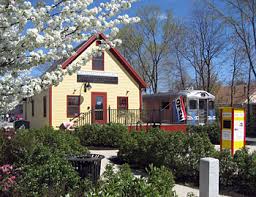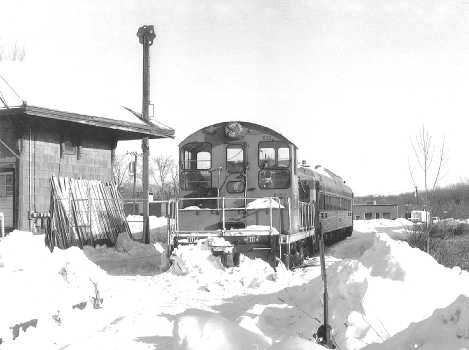Reformatory Trail has been in the news lately. Ten years ago it was decided that the Minuteman Bike Trail should be extended and paved all the way to the Concord line as part of a wider transportation goal. At the upcoming Special Town Meeting a vote will be taken on the final stage of the project. There is a lot of passion on both sides as to whether it should be paved or remain the way it is.
We thought it might be interesting to look back at the history of the trail.
The Bedford Depot Park has a timeline with lots of great history and artifacts about the rail service in town. The following is a summary of their timeline on the Reformatory Trail.

A Chronology of Bedford’s Railroad History
The Reformatory Trail is the name given to a rail line that went from Bedford Depot to Concord. The station was located across from the prison, thus was dubbed the Reformatory Station. Train lines are named after the two terminus points of a particular line.
The Reformatory Line is part of an extensive history of rail travel around greater Boston. The very first rail line was the Boston-Lowell line. One of the first commercial rail lines in the country, it was completed in 1835. The rail line was created to replace the canal system in Lowell and would allow year-round freight travel. Before the rail line was created a canal system was used to transport goods. When the canal froze in the winter, it made the system unusable.

In 1846 the Lexington and West Cambridge (now known as Arlington) Railroad was completed. This line was later purchased by the Boston & Lowell Railroad in 1870. In 1872, the Boston & Lowell Run created a subsidiary, the Middlesex Central Railroad, for the purpose of extending its Lexington Branch eight miles further west through Bedford to Concord Center. In 1873, they opened the new Bedford-Concord line. In 1879, another branch was opened to extend the line 2.5 miles further to Concord, ending at Reformatory Station across the street from the prison.
In 1887, the Boston & Maine, or B&M, took over the Boston & Lowell Railroad including the Lexington and Reformatory branches. The B&M continued operation of the branches until 1926. In April 1926, the B&M ended passenger service on the Reformatory Branch. In 1927, the B&M formally abandoned the 2.5-mile section of the Reformatory Branch between Concord Station on Lowell Road and Reformatory Station on Elm Street. The remaining section of the Reformatory Branch between Bedford Depot and Concord Center was maintained for freight service. Then in 1962, the B&M Railroad abandoned the remainder of the Reformatory Branch between Bedford and Concord Center and the section of the Lexington Branch between Bedford Depot and Concord Road in Billerica. The Town of Bedford purchased the two rights-of-way (the portions within town limits) a year later.

In 1965, the Massachusetts Bay Transportation Authority, having taken over the lines from B&M, started to subsidize commuter rail service. Originally, the Lexington line was not included but was subsequently reinstated after protests. Commuter rail continued to be operated by the MBTA until 1977. The commuter rail service continued to Bedford until January 10, 1977. On that fateful day, a snowstorm blocked the Lexington Branch, preventing the train from North Station to Bedford from running for days. After days of no Lexington Branch service, the MBTA announced that it was discontinuing commuter rail service on the line.

The track was still owned by B&M, which filed for abandonment of the branch in March 1979, allowing the Alewife Garage to be built. An interesting side note: at one point the MBTA Red Line was supposed to extend all the way to Route 128, and there was even some talk of extending the Red Line to Hartwell Avenue in Lexington! The plan was to be implemented in two steps, with a temporary termination of the line in Arlington Center. However, Arlington objected to the temporary terminus of the line in their town, so it was decided to end the Red Line at the current Alewife location.
In 1980, a Federal judge ruled that after construction of the Alewife Station Garage, the Lexington Branch must be restored over the right-of-way. In 1981, the MBTA entered into an agreement with the Town of Arlington to advocate that the Lexington Branch be abandoned. In return for the MBTA’s support for converting the railroad to a bikeway, Arlington allowed the MBTA to use some of its land as a construction staging area for the Red Line extension project.

Converting The Rail Line to a Bike Path
Railbanking is the act of preserving railroad rights-of-way for possible future use. Railbanking of the line was first proposed in 1974. However, it wasn’t until 1991 that the final plan for the conversion to a bike trail was approved, and construction started on the Arlington–Lexington section of the bike path. The Lexington–Bedford segment was opened in May 1993.
Bedford’s Part of the History of Converting Rail Lines to Bike Paths
An interesting part of our local history to convert the narrow gauge railroad rail lines into the current configuration of a bike path involved Bedford fifth graders. In 1970, 21 students from Ralph Hammond’s social studies class at Bedford’s Center Elementary School noticed that there were few accessible and safe places in Bedford for kids to independently ride their bikes to school or home. The students came up with a solution, and after presentations and petitions, the students got their two proposals onto the Town Warrant! They were awarded a total of $10,500 for the narrow gauge rail bed path improvement in 1971.
































What an interesting history! I love the bike path and other rail trails, but wouldn’t it have been wonderful to have commuter rail service to Boston from Bedford to ease traffic congestion in town. Can’t have our cake and eat it too, I suppose!
The MBTA still has rights to the trail, so should they ever want to restart trail service, they can reclaim the trail. (That’s why it’s called rail banking). The MBTA had filed the appropriate paperwork to renew their rights every time they have to.
To be clear, both the Reformatory Branch and Narrow Gauge Trails owe their existence to the efforts of those 21 students. The two trails might actually be the very first rails-to-trails conversions in the United States.